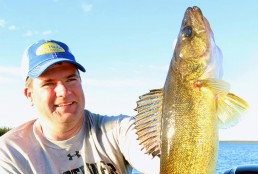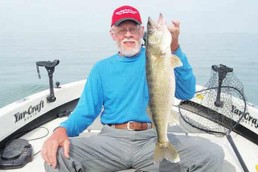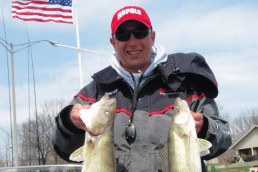The Meanest Walleyes Lay Down Roots in Weeds
SHARE THIS POST
I make no secret of my love for shallow weed-pattern walleyes. These fish are aggressive and will hit baits with force. Spend any time chasing muskies, and sooner or later, you won’t be surprised to find your retrieve interrupted by a big old “Walter” smashing down on a bucktail or spinnerbait. These weed fish don’t even act like the walleyes many of us were groomed to catch in our youth when we thought we had to use 6-pound-test and fish as slowly and as close to the bottom as possible. These fish play by a different set of rules, and more anglers have discovered that weed walleye patterns happen throughout the summer.
As a general rule, most walleyes do seem to follow the old playbook: move out over deep structure and basins as summer progresses. But there always seems to be a percentage that stays in shallow weeds throughout the season. These patterns can be as fickle and fleeting as any other, but what makes weed patterns appealing to this angler is that they are often overlooked because many walleye anglers hate fishing weeds. On many fisheries, from Saginaw Bay to the Missouri River to reservoirs to lakes in between, these populations don’t get touched and this makes these patterns so good.
Both flats and contours can hold fish, and there are many ways to fish weed walleyes, but there are a couple of presentations that really shine depending on the profile of the weed bed. Day in and day out, a swimbait with a large plastic paddle tail is tough to beat. The reason swimbaits are so deadly around weeds is because of the large-gap single hook that can be snapped and shredded through weed stalks and because the larger hook allows you to put more pressure on fish and keep them hooked up. Now fluke-style and curl-tail baits can all work, but I have always been a fan of a large paddle tails because of the vibration and thump that comes off these baits. I believe this thumping tail does the best job of pulling fish up out of weeds because fish feel the vibration.
Fishing these baits is merely swimming and sliding along the edges and open pockets or over the tops of emerging weeds while snapping or popping the lure when you make contact. This snap or pop not only cleans off hooks, but also triggers strikes. If anglers make a common mistake with
swimbaits and weeds, I would dare say that many use too small of a swimbait. Four-, 5-inch or sometimes larger swimbait bodies present an easy target, move water and slide and glide more slowly toward the bottom, so the bait can be swam just over the tops or through the edges of weeds. Soft plastic swim bait options that have large paddles and offer exaggerated vibration, like Kalin’s Sizmic Shad, are the meal ticket.
The biggest challenge I find when targeting weed walleyes through the summer is that weeds can grow amazingly fast, so you have to relearn your locations. There are times when the weeds can literally grow 6 more inches in a matter of a few days. Early in the season when the weeds are just starting to grow, fishing is relatively easy. As the weeds begin to reach for the surface, the windows of clean water become more precise and narrow. A particular size of swimbait or jig hook that was perfect a week ago can become obsolete when the profile of a weed bed changes.
Finding the right lure and fishing the right angle so that the lure can be worked clean through the correct zone, takes a somewhat methodical approach. When the fish are aggressive and cruising higher in the water column or roaming the open pockets or open water above the weeds, these fish are easy. When fish are tighter to the bottom or along the bottom edge of weeds where they become deeper and sparser, the window is more limited because you are going to need a presentation that lands in front of them. This is exactly why swimbaits shine day in and day out because the depth can be manipulated and controlled so that the bait fishes down to the fish.
Are you enjoying this post?
You can be among the first to get the latest info on where to go, what to use and how to use it!
In my opinion, swimbaits are the perfect one-two punch when you combine hard baits into your repertoire. For covering water or picking off the aggressive fish riding high in the weed bed, you can use crankbaits or stickbaits successfully. Last summer, we filmed an episode in South Dakota’s Glacial Lakes Region, near Webster, where we caught some really big fish rolling Salmo Stings over 7- to 9-foot weed flats. The weeds nearly reached the surface, and this particular shallow-running, suspending “twitch” bait proved deadly. You can cover more water with a faster trolling motor speed when using hard baits and most definitely wear out the aggressive, easy-to-reach fish in a particular weed bed.
What always shocks me, however, is the number of fish that can be tallied by going through the same weed bed at a slower, more methodical speed with swimbaits. These catch fish that the crankbaits miss.
Why these two lure categories complement each other so well stems from the dive curve each bait possesses. Imagine a standard crankbait or stickbait going through the water column during a retrieve: The dive curve is going to be half-circle-shaped. Snap the lure to get it down and the lure is going to be at the deepest about halfway through a retrieve before it begins to rise toward the boat. With hard lures, you can clip the tops or sides of the weeds at a faster rate. Hard lures typically have more noise and flash, and can probably pull fish in from greater distances. These characteristics make them shine for finding fish, eliminating water and catching fish that are on.
The swimbait takes a different route back to the boat that can be manipulated much more so than hard baits. The swimbait can be retrieved to take a similar half-circle-shaped route back to the boat in a more subtle fashion, but it can also be lifted or dropped to cover a portion of the water column that hard baits will miss and do so at a slower speed. When fish are tucked in tight to the bottom of the weed bed or are holding tight along an inside or outside edge, you can reach these with a swimbait. The single hook is also easier to clean and free when you make contact versus the multiple hooks on a crankbait or stickbait.
What is really neat about weed walleyes is that they are typically “homebodies” in that they don’t move like fish on other patterns. When conditions change, these fish simply lay in the bottom of the weeds and don’t often show the vertical or horizontal movement of moving up and down like structure fish that might move from 20 feet up into 10 feet. Weed fish seem to hold in the same depth of water, but merely move up or down in that specific depth. In other words, these fish don’t always seem to slide out over deep water or slide down the break; they merely quit swimming and drop to the bottom when they are off. Weed fish are often dark and brilliant in color too, which points to a resident lifestyle where as washed out-appearing fish are fish on the move.
When these are on, they are extremely underrated predators that can outcompete both bass and pike on many bodies of water. These fish won’t need finesse, and that is what makes this style of fishing so much fun. Combine the aggressive nature of these shallow fish with warm-water temperatures and you have a hard-hitting, hard-fighting species that surprises you no matter how many you catch. Every year, I catch a few of these where the hit is so abrupt and sudden and the fight so determined, that I say to myself: This can’t be a walleye.
Jason Mitchell is a top walleye guide on Devils Lake, N.D. He is the host of the outdoor program, “Jason Mitchell Outdoors.” Visit jasonmitchelloutdoors.com for more.
MWO
SHARE THIS POST
Did you enjoy this post?
You can be among the first to get the latest info on where to go, what to use and how to use it!
Jason Mitchell
Jason Mitchell was a top walleye guide on Devils Lake, N.D. for nearly 20 years. Today, Mitchell produces the Jason Mitchell Outdoors TV program. Visit jasonmitchelloutdoors.com for more.




